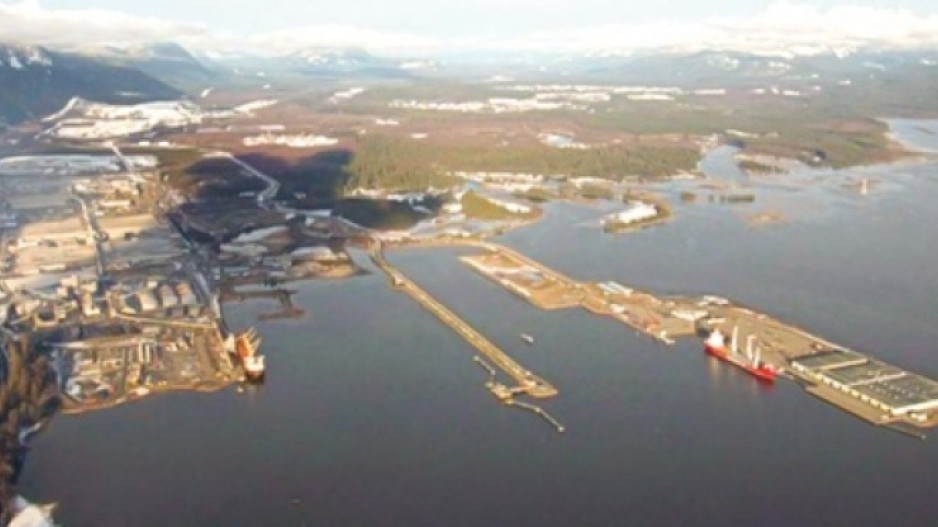The National Energy Board should find that the provincially approved pipeline that will transport natural gas from northeast British Columbia to the LNG Canada export project in Kitimat is properly within provincial jurisdiction, says the Canadian federal government.
In written argument submitted to the board's hearing into the jurisdiction of the Coastal GasLink pipeline project, the Attorney General of Canada rejects the arguments of environmentalist Mike Sawyer and Ecojustice that the project is a "federal undertaking" and as such should be federally regulated.
The federal government takes the position that the Coastal GasLink pipeline project is not a "federal undertaking" and is therefore not under the legislative authority of the National Energy Board Act.
"The Coastal GasLink pipeline project, located entirely within British Columbia, is not physically connected to the [federally regulated] NGTL and does not depend on the NGTL System for its gas to transport to the LNG Canada facility," says the government.
"Though both are wholly owned subsidiaries of TransCanada Pipeline Ltd., they have separate corporate structures that provide for separation of management, decision-making, information sharing and other aspects of operation and control."
Further, there is no relationship of dependency between NGTL and the project, the government argues. "None of the participants have current arrangements or contracts with NGTL to supply gas for transport to LNG Canada and any potential future commercial arrangements between a participant and NGTL would have no bearing on the project's separate transportation function as a standalone operation," it says. "In addition, the project is neither designed or approved to flow gas east to the NGTL System; there is no interconnection between LNG Canada and NGTL."
CGL in its submission maintains that its project should be provincially regulated. However, if the NEB determines it is a federal work, the public interest requires the board to establish further processes for an orderly transition to federal jurisdiction to ensure no regulatory "gap" is inadvertently created and that construction of the pipeline (and the associated LNG Canada facility) is not frustrated, says the company.
In his submission, Sawyer argues that Coastal GasLink is functionally integrated with the NOVA system as they are parts of TransCanada's undertaking to move gas from the Western Canada Sedimentary Basin to the LNG export market. The CGL pipeline, he says, will connect to the NGTL System and gas for the pipeline will come from the existing NGTL System, as well as from other pipelines.
Sawyer says he specifically disagrees with CGL's suggestion that should the NEB find the pipeline is under federal jurisdiction it should suspend the declaration of federal jurisdiction until the board has issued a certificate of public convenience and necessity (CPCN) for the facilities which have just started construction.
"If CGL is in federal jurisdiction, then it requires a CPCN under the NEB Act," he says. "The board will need the declaration of federal jurisdiction over CGL to provide constitutional support for the exercise of its statutory powers necessary to process and determine a CPCN application for CGL if one is forthcoming."
In its submission, Ecojustice says it adopts Sawyer's arguments that the entire constitutional analysis is currently based on reasonable expectations that will materialize in the future. "The pipeline is not yet constructed and it is reasonable to expect a physical connection between CGL and the NOVA Gas Transmission Line System," it says.
"In light of this reality, the time for the board to exercise its jurisdiction is now, otherwise it risks constraining the legal duties that must be exercised by the board and other federal authorities when the project falls under federal jurisdiction."
For example, if the project falls under federal jurisdiction, it would require a certificate of public convenience and necessity (CPCN) from the NEB and a report to the federal minister with a recommendation and any conditions to be imposed by cabinet, says Ecojustice.
In addition to the requirements under the NEB Act, other federal statutes such as the Canadian Environmental Assessment Act, 2012 and the Species at Risk Act impose requirements on projects under federal jurisdiction, according to Ecojustice. "Should the project fall under federal jurisdiction, the project would legally be subject to the requirements of both these federal statutes."
If Coastal GasLink is substantially constructed or even completed by the time it is realized that it is subject to federal jurisdiction, the rigour and purpose of an assessment under CEAA, 2012 would be fundamentally compromised, says the group. "Likewise, the ability of decision makers under CEAA, 2012 to determine whether to justify any significant adverse environmental effects or to impose meaningful conditions or recommendations would be severely constrained."
Similarly under SARA, says Ecojustice, the board may find it is unable to ensure measures are taken to lessen or avoid the impacts of the project on listed wildlife, and thereby fail to comply with the requirements of that statute.
The hearing will be held May 2 and May 3 in Calgary.



